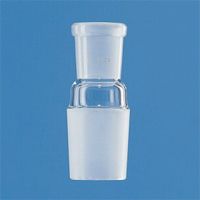
mycotheologist - 26-4-2012 at 18:13
I want to start MacGyvering chemistry apparatus more often so I'm going to improvise the next thing I need which is a device for bubbling Cl2 gas
through water in order to remove any HCl from the gas. I want to just use a glass, jam jar with a HDPE lid. I'll make two holes in the lid for and run
the input and output tubing through the holes. I'll need to seal the edges of the holes around the tubing though and since I'll be doing this kinda
thing way more often from now on, I want to find a good, inert material for this kinda thing. According to this page:
http://www.musicdirect.com/p-6739-blu-tack.aspx
blu-tac has good resistance to mineral acids and bases which would make it useful for what I'm doing but it has poor resistance to solvents so it
wouldn't work in other situations. Also, I don't know what the Cl2 will do to it.
For more permanent setups, these all purpose fillers:

which solidify into cement like CaSO4 would work.
EDIT: Also, another idea I had for running glass tubing into a flask was to fill one of these type of joints:

with a blu-tack like material then stick the glass tube through it. Has anyone here tried this?
[Edited on 27-4-2012 by mycotheologist]
Pyridinium - 26-4-2012 at 20:02
There could be some reaction and also bond cleaving when Cl2 comes into contact with the hydrocarbon polymer components of blu-tack. (offhand I think
Cl2 is one of the only common things that will react with alkanes at room temp).
Your basic idea with the glass adapter sounds good as long as the temperatures were kept close to room (wouldn't want it failing if working with
Cl2)... now, the question is... that Cl2 again vs. the filler.
Way back when there was litharge cement, great for most things except sulfuric acid, though not sure how it does with chlorine.


